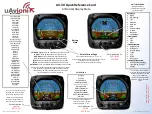
Primer
Crestron
Surround Sound
differences can be perceived when two pitches interfere and are heard
as a frequency difference pitch.
The lower limit of audibility is defined as 0 dB, there is no defined
upper limit. The upper limit is more a question of where the ear will be
physically harmed. This limit depends on the time exposed to the
sound. The ear can be exposed to short periods of sounds of 120 dB
without harm, but long exposure to 80 dB sounds can do permanent
damage. The human voice range is about 68-76 dB; a jet plane creates
about 120 dB of sound.
Sound waves radiate out from the source in straight lines regardless of
frequency or wavelength. But low frequency (long wavelength) sounds
do not fit in confined spaces. They loose their directional character and
that is why you only need one subwoofer for a sound system; you can't
tell where the lowest frequency sounds are coming from when the
sound is confined in a room.
The model of sound so far described is a simplified version, operating
in just one dimension (as opposed to the real world three-dimensions),
and assumes that the vibrating particles of air are held semi-rigidly. In
the real world, air molecules are in constant random motion in all three
dimensions. Air pressure constantly changes as the molecules collide
and rebound from each other and from objects in the environment. This
random motion creates a background level of noise and helps define the
lower limit of hearing.
Timbre
Musical timbre is a property of sound. It is composed of spectral
components containing perceptual cues, and can be described by
Fourier series coefficients. The spectral “envelope” of a sound, the
profile of the Fourier series, is the sound amplitude behavior over time.
The pattern that this sound pressure variation creates is the waveform
of the sound.
Timbre is the temporal evolution of the spectral envelope. This
envelope consists of an "attack" portion at the beginning or onset of the
sound, a sustained portion (stationary state), and a decay portion.
Timbre has psychoachoustic properties. A number of transient
fluctuations occur during the initial part (attack), for example, the
moment a violinist puts the bow to the string. These are called
onset
transients
and are important in identifying the sound and its location in
space.
4
•
Surround Sound
Primer – DOC. 6122









































